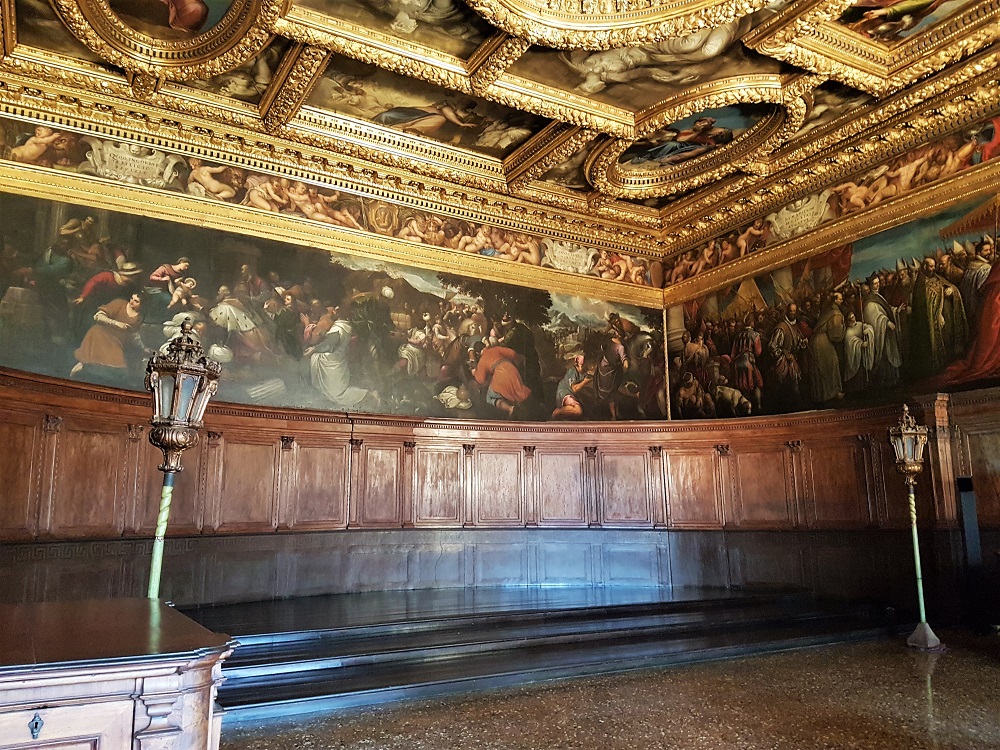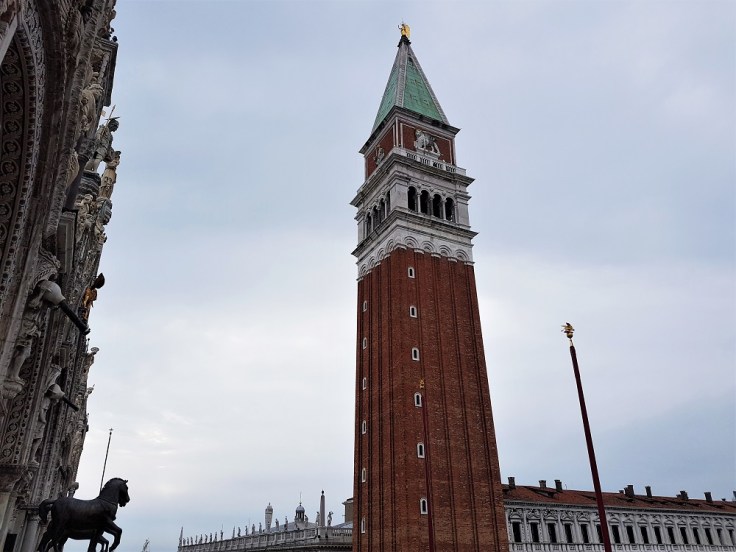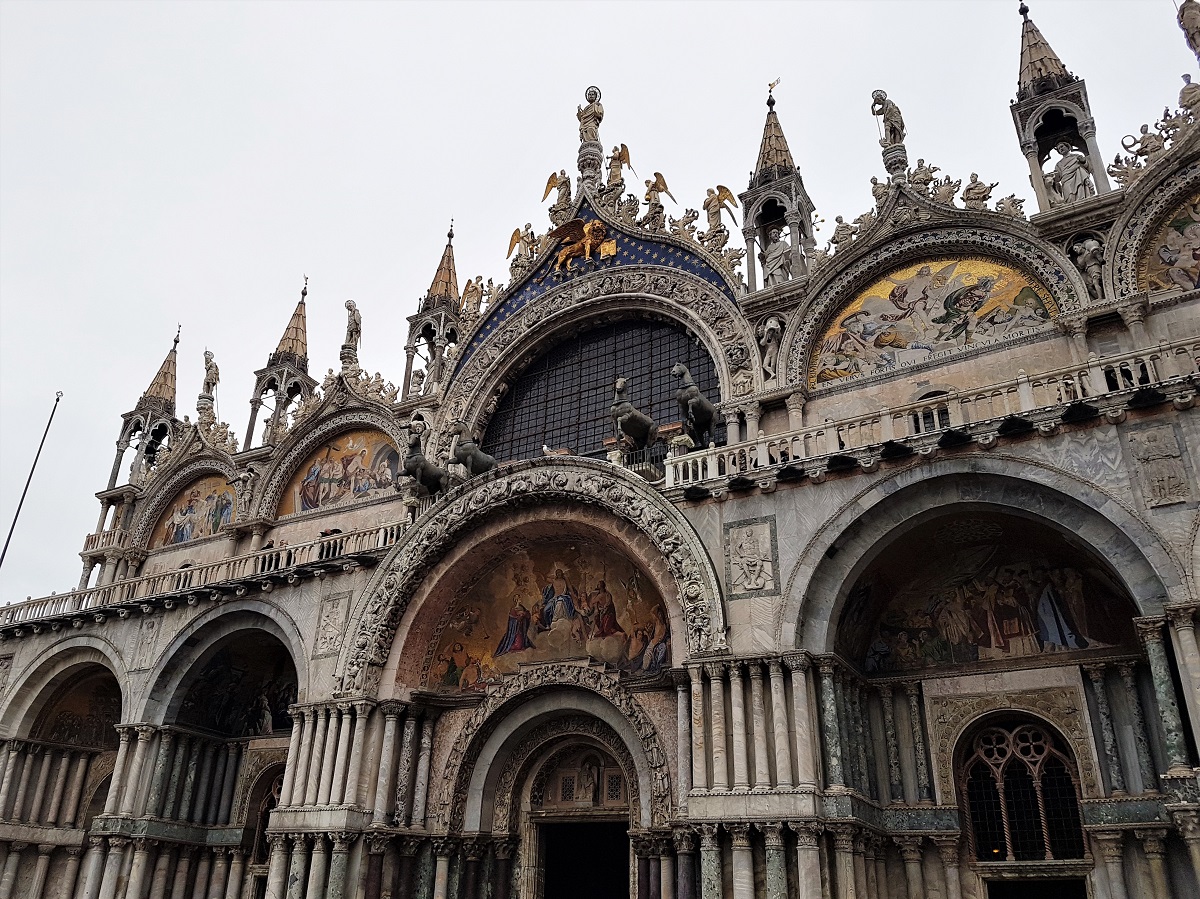No trip to Venice would be complete without a visit to its most famous square, the Piazza San Marco, and the iconic sites that surround it, the Basilica di San Marco, the Palazzo Ducale and the Campanile.
So after cruising down the Grand Canal, we disembarked at San Marco, where we stopped to take some photos of the island of San Giorgio Maggiore (below).

Unsurprisingly, the area was very busy as we walked across the quay to the small bridge next to the Palazzo Ducale to take a look at the Bridge of Sighs (below).

I hadn’t realised before I went to Venice that this famous bridge with the romantic name was built to connect the palace to the prison on the other side of the canal.
The bridge’s nickname was coined by Lord Byron to commemorate the fact that the view from the bridge would be the last time the prisoners saw Venice before taking up residence in the cells.

From the Bridge of Sighs, we walked around the corner to the Piazza San Marco, home to the glorious Basilica di San Marco (St Mark’s Basilica, above).
Although the Byzantine masterpiece dates back to the 11th century, the church itself was founded in the 820s to house the remains of the city’s patron saint, St Mark, which a couple of Venetian merchants had spirited away from Alexandria.
The cathedral boasts five domes, countless magnificent mosaics and a myriad of treasures, including four remarkable bronze horses, which were looted from Constantinople in 1204.
Photos don’t do justice to just how beautiful the basicila is.
Its striking exterior boasts an unusual multicoloured marble façade. While the balcony, which overlooks the piazza, features replicas of the aforementioned bronze horses (the originals are housed in the cathedral’s museum).

The basilica is just as splendid inside, although I was surprised by how small, square and short it is.
Its walls are adorned with gold mosaics that depict scenes from the Bible, while its beautiful, yet uneven floors are marked by marble mosaic tiles in a sea of pink, grey and white.
Visitors have to follow a designated route around the basilica and photos are forbidden (hence the lack of photos).
This rule is strictly enforced and I watched more than one security guard berrating cheeky tourists who were caught flouting the ban.
As we followed the guided path around the cathedral, I couldn’t help but notice the slight whiff of sewage, a remnant of the flooding that had occurred two months earlier.
To the right of the guided path, we stopped to take a look inside the basilica’s treasury (entry €3), a tiny, two-room museum home to gold artificats and jewels.
Most of these treasures seemed to have been looted from Constantinople when the Venetians sacked the city in the 13th century, a fact the museum conveniently failed to mention.
Rejoining the main path around the basilica, we soon stopped again to pay another €2 to see the spectacular Pala d’Oro.
The Pala d’Oro is a jewel-encrusted altarpiece made up of 250 gold enamel paintings that sits behind St Mark’s tomb.
Napoleon reportedly helped himself to a few of its jewels in 1797, but the missing jewels have done nothing to lessen the dazzling impact of the altarpiece.
At the end of the tour, we made our way up a narrow, rickety stone staircase to the Museo Marciano, which overlooks the basilica and boasts superb views over its stunning interior.
The Museo Marciano houses a series of paintings, tapestries, panels, objects and choirbooks from the cathedral.
But its most famous artifacts are the extraordinary bronze horses. They’re incredibly lifelike and I can understand why the Venetians took such a fancy to them.

From the museum, you can wander outside onto the terrace that extends across the front and left side of the basilica to admire the views over the Piazza San Marco (above) and the Palazzo Ducale.
By now we’d seen everything there was to see in the cathedral, so we headed outside to the square, where it’s been illegal to feed the pigeons since 2008.

We crossed the piazza for a quick pick-me-up at Florian (above), a Venetian institution, where we had some overpriced drinks.
My ‘Cioccolata Casanove’, a mint-flavoured hot chocolate (below), may have cost a whopping €13.50, but it was exceptionally good.

The same cannot be said of the service. The waiters were so rude, I was tempted not to leave a tip and even less impressed by their attitude given how much the café charges its customers.

Appalling service aside, we left Florian on a sugar high and made our way to the Palazzo Ducale (above).
The delightfully pretty palace, which was founded in the 9th century, was built between the late 14th and early 15th centuries.
The former home of 120 of Venice’s doges (its elected rulers), the Palazzo Ducale was also the meeting place of the city’s council.

After buying our tickets, we made our way into the palace’s courtyard, where we had a good look around, stopping to admire the Giant’s Staircase, where the city’s doges were once crowned (below).

We then popped inside a small museum just off the courtyard that showcases columns and statues from the palace, before heading upstairs to the ducal appartments, where we stopped en route to see a small exhibition of paintings by the likes of Reubens, Titian and Van Dyck.

We began our tour of the ducal appartments in the opulent state rooms, which owe much of their jaw-dropping splendour to the decorating skills of several Venetian masters, including Titian, Bellini and Tintoretto (above).

The bare rooms are adorned by their great artworks, dark wood panelling and lots of gilding. But I was particularly taken by the elaborate ceilings (above and below).

There’s no furniture on display thanks to a certain Napoleon Bonaparte, who invaded Venice in 1797, looted the palace and toppled the last of Venice’s doges, Ludovico Manin.

As we walked through the state rooms, it was clear just how rich Venice had been during its heyday and any visitors to the palace must have been overawed by the imposing sight before them.

By far and away the most impressive is the Sala del Maggior Consiglio, an enormous wood-panelled room that’s covered in a series of paintings by Tintoretto (above and below).

It’s a breathtaking sight and one of the most magnificent, opulent and extravaggant rooms I’ve set foot in (and I’ve visited a lot of chateaux, palaces and cathedrals over the years).
It certainly rivals anything in the Vatican and I was somewhat surprised it isn’t more famous.

The third floor of the Palazzo Ducale was once home to the city’s council chambers, including the Sala del Consigli dei Dieci (above), where the city’s Council of Ten would meet.
The Council of Ten was responsible for Venice’s security and its elected members would meet in the chamber to discuss crimes relating to the state’s security.

Having seen everything there was to see in the state apartments, we entered a small passage (above), which took us over the Bridge of Sighs to the prison on the other side of the canal.

The extensive prison complex spans multiple floors and is made up of one cold, bare cell after another. It must have been a pretty grim place in which to have been imprisoned (above).

The most famous prisoner to call the cells home was Casanova, the author, adventurer and philanderer, who escaped from the jail in 1756 in an elaborate and daring plan after five months inside.

By now we’d seen everything in the Palazzo Ducale, so we made our way to our final port of call, the Campanile (above).
The distinctive bell tower on the edge of the Piazza San Marco is the tallest structure in the city at 98.6m (323ft).

It was originally built as a lighthouse in the 12th century before being turned into a prison during the Middle Ages, where the unfortunate prisoners were hung in a cage near the top of the tower.
Tragedy struck in July 1902 when the Campanile collapsed and a replacement tower was unveiled to the public nine years later.

The only way to the top of the Campanile is via a lift, which we squeezed inside along with a number of other people, as we were keen to take in the 360° views over the city (above).

The views from the top of the tower are spectacular and I was particularly enraptured by the view towards the lagoon and San Giorgio Maggiore (above).
It was a fantastic way to end to an enjoyable tour of San Marco and its many unforgettable sights.

The ceilings in the Palazzo are incredible. Who needs furniture when you have those ceilings! Maggie
LikeLiked by 1 person
They’re amazing. I think I spent more time looking up at the ceilings than I did looking around the rooms!
LikeLiked by 1 person
I would have too!
LikeLiked by 1 person
I absolutely loved the San Marco area – there is just so much to see and do there and it’s all so historic and beautiful. Your photos are gorgeous.
LikeLiked by 1 person
Thanks Hannah 🙂 It’s an incredible district and a real must-do in Venice. As you say, there’s so much to see and everything’s ridiculously beautiful.
LikeLike
Hello. Great tour. Thanks. When I was on Piazza San Marco years ago, hundreds of pigeons were all over the place. Neil S.
LikeLiked by 1 person
Thanks Neil. There aren’t many pigeons around there these days, probably because they aren’t being fed in quite the same way any more!
LikeLiked by 1 person
I loved to explore the San Marco area in Venice. Despite containing numerous things to see, I found that this neighbourhood’s most attractive attribute is its small and narrow alleyways that are very often accompanied by small winding canals. Going for a stroll in San Marco is extremely enjoyable, as you can breathe in the Venetian atmosphere. Thanks for sharing and have a good day 🙂 Aiva xx
LikeLiked by 1 person
Thanks for commeting Aiva. I agree, there’s far more to San Marco than just its most famous sights and we also spent some time wandering around its streets and alleyways. Venice is a superb city for walking, although thanks to the winding canals, I found it was also very easy to get lost there!
LikeLiked by 1 person
Amazing views from the Campanile. Venice is absolutely gorgeous and an absolute history and art treasure trove of a city as your article demonstrates. How magnificently rich it must have been in its zenith. I skipped Cafe Florian during my visit, though I did stop for an exceptionally overpriced cup of coffee somewhere on San Marco Piazza. How sad to hear that a quaint experience of having a drink at one of the most famous cafes in the world is spoiled by rude waiters. I love the multicoloured marble exterior of the Basilica and that ceiling in the Palazzo leaves me wanting for words.
LikeLiked by 1 person
Thanks Leighton, it’s incredible how much wealth, art, history and beauty there is to see in the city. It seems a bit of a rite of passage when in Venice to find yourself in a ridiculously overpriced cafe in San Marco, although I hope the coffee was good and you had better service than I did! The basilica’s multicoloured marble façade is striking, and I was just awe-struck by the ceilings in the Palazzo Ducale. I seem to have more photos of the ceilings than anything else in the palace.
LikeLiked by 1 person
I didn’t know that either about the Bridge of Sighs until we took the Secret Itineraries tour through the Doge’s Palace. That mind-flavoured hot chocolate looks delicious, but oh wow was it expensive! It sounds like you managed to hit up all the highlights in St Mark’s Square.
LikeLiked by 1 person
The Secret Itineraries tour sounds interesting and a great way to learn more about the history of the palace and the prison. I expected to be charged sky high prices in the cafés around San Marco, but even so, it was a lot more expensive than I’d anticipated! At least it tasted good, otherwise I’d have been left very disappointed.
LikeLiked by 1 person